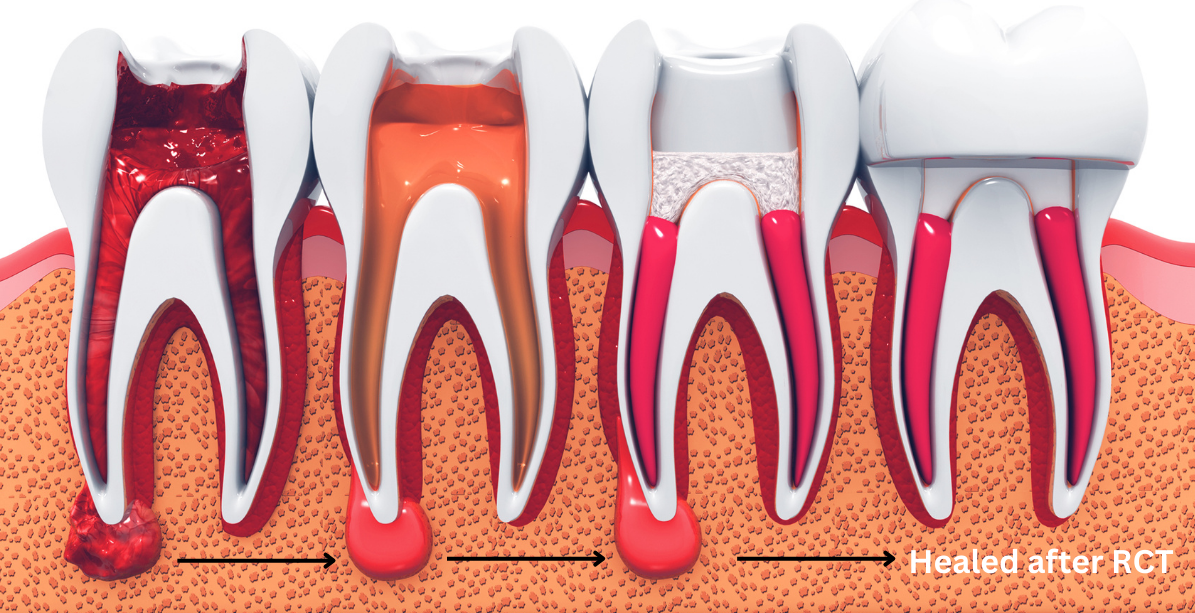
Pain After a Root Canal
Understanding Post-Root Canal Pain and What You Should Expect
A root canal treatment is often the go-to solution to eliminate tooth pain caused by infection or deep decay. But what happens if your tooth still hurts after the root canal? Many patients wonder, “Is it normal to have pain after a root canal?” Let’s explore the truth behind post-root canal discomfort and when it’s a sign to see your dentist again.
Why You Might Feel Pain After a Root Canal
- Is It Normal to Have Pain After a Root Canal?
Yes—mild to moderate pain after a root canal is quite normal and typically lasts a few days to a week. The procedure involves removing infected pulp, cleaning the canals, and sealing the tooth, which can irritate surrounding tissues. This inflammation may lead to temporary tooth sensitivity or soreness.
- Common Causes of Pain After a Root Canal
- Tissue inflammation around the root
- High bite pressure due to improper crown height
- Temporary filling leakage
- Instrument-related irritation inside the canals
- Infection that wasn’t fully resolved
Understanding these reasons helps answer the question, “Why does my tooth still hurt after a root canal?”
How Long Does Pain Last After a Root Canal?
Post-treatment discomfort generally lasts between 3 to 7 days. Some sensitivity when biting or chewing is expected. However, if pain lasts more than 7–10 days, or worsens over time, it may indicate a complication such as:
- Persistent infection
- Missed canal
- Cracked tooth
- Periapical abscess
When Post-Root Canal Pain Is Not Normal
While mild pain is normal, seek dental help if:
- You have throbbing pain after a root canal
- There’s severe swelling or fever
- You feel pain after a week or longer
- The tooth becomes tender to touch or pressure
- You notice a bad taste or drainage, which could suggest infection
How to Manage Normal Pain After Root Canal
- Take Pain Medications as Prescribed
Ibuprofen or paracetamol can reduce inflammation and manage discomfort.
- Avoid Chewing on the Treated Tooth
Until the permanent crown is placed, minimize chewing to prevent stress on the tooth.
- Use a Cold Compress
Applying ice to the cheek can reduce swelling and numb the area temporarily.
- Maintain Oral Hygiene
Brush and floss gently to keep the area clean and promote healing.
Can Pain After Root Canal Indicate Treatment Failure?
Sometimes, yes. If pain is persistent or severe, it could mean:
- A canal was missed
- The infection wasn’t completely removed
- There’s a crack in the tooth
- The seal or filling has leaked
Your dentist may recommend retreatment, a root canal re-do, or in rare cases, an apicoectomy (removal of infected root tip).
Final Thoughts: Is It Normal to Have Pain After a Root Canal?
To summarize, mild pain after a root canal is completely normal, especially within the first few days. It shows that the body is healing. However, if the pain persists, worsens, or is accompanied by other symptoms, don’t ignore it—consult your dentist right away.
FAQs
- Can you get an infection after a root canal?
Yes, although rare, a root canal-treated tooth can become reinfected due to incomplete cleaning, missed canals, a cracked tooth, or delayed crown placement. Signs include swelling, pain, or pus discharge.
- What does a failed root canal feel like?
A failed root canal often causes persistent or recurring pain, sensitivity to biting, swelling, or a pimple-like bump on the gums. It may also lead to a dull ache or pressure in the area.
- How do I know if my root canal is healing properly?
Mild pain or tenderness for a few days is normal. Proper healing includes gradual pain reduction, no swelling, and the ability to chew without discomfort. If pain worsens or lasts beyond two weeks, consult your dentist.
- Can a root canal tooth hurt years later?
Yes, though uncommon, pain can occur years later due to reinfection, new decay, gum disease, or a cracked root. A dental exam and X-ray can help identify the cause.
- What should I avoid after a root canal?
Avoid chewing on the treated side, especially hard or sticky foods, until a permanent filling or crown is placed. Also, avoid smoking, alcohol, and extreme temperature foods to aid healing.
- Is swelling normal after a root canal?
Slight swelling may occur right after the procedure but should subside within a few days. Persistent or increasing swelling may indicate infection and needs prompt dental attention.
- Can you eat normally after a root canal?
You can eat soft foods after the anesthesia wears off, but avoid hard, crunchy, or chewy foods until the final restoration (crown/filling) is completed. Always follow your dentist’s dietary instructions.
- Do I need antibiotics after a root canal?
Not always. Antibiotics are prescribed only if there’s active infection, significant swelling, or systemic symptoms like fever. Most root canals heal well without antibiotics if cleaned and sealed properly.
- How long does it take to fully heal after a root canal?
Healing usually occurs within 1–2 weeks. However, full bone healing at the root tip may take months. Pain should subside within a few days, and chewing should feel normal after permanent restoration.
- Can a crown cause pain after a root canal?
Yes, if the crown is too high, poorly fitted, or pressing on surrounding tissues, it can cause pain. Sometimes, underlying issues like inflammation or cracks can also contribute. Your dentist can adjust or replace it if needed.
